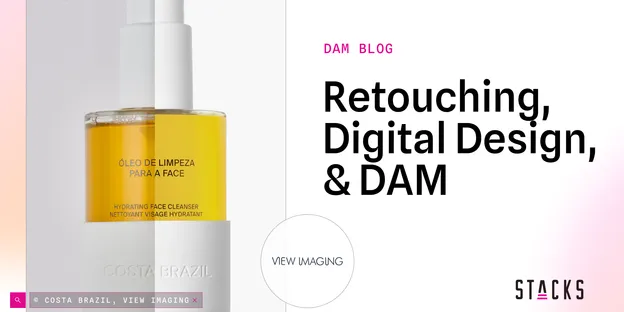In today’s world, the key to generating legitimate traffic for your brand and connecting with consumers is unique, compelling marketing content.
Any brand can pump out cookie-cutter content and manufacture a brand identity that seems unique and authentic, but few organizations are actually set up to allow their creative teams to flex their skills and truly innovate. Clear brand guidelines and content strategy are vital to a healthy and consistent brand identity, but these should serve as boundaries, not prisons that restrict creativity.
To create effective marketing content, the creative process must be organized in a way that encourages innovation while maintaining brand identity. In this article, we’ll discuss how digital asset management (DAM) can help you accomplish this at your organization.
Enabling Creativity through DAM
What processes, tools, and capabilities do a graphic designer, photographer, or other creative need to be successful in their role? In addition to brand guidelines and content strategy, there are several other ways that digital asset management can enable successful creative operations, both by speeding up workflow and providing creative direction.
Brand Guidelines & Content Strategy
As we’ve already mentioned, when brand guidelines and content strategy are used in the proper context, they provide the structure and boundaries that allow your creative team to create effective new on-brand content.
If you haven’t already done so, be sure to collect the creative materials you use regularly and review them for messaging, content, and overall look and feel. Are you presenting your brand the way you want to? Are the strengths and differentiators, the things that make your brand unique, shining through? Would a consumer call your brand genuine and authentic?
If you’re able, include your creative team in the process of developing and documenting your brand guidelines and content strategy. This creates buy-in and ensures that any ideas they have for new content are within the boundaries of your brand. If your creative team hasn’t been involved in the process, be sure to communicate your new brand guidelines and content strategy with them.
Access to Pre-Existing Assets
While brand guidelines allow space for creativity, access to pre-existing creative assets can make the creative process more efficient. Unless your organization is undergoing an entire rebranding process, odds are that many of the creative assets stored on servers, local hard drives, a cloud-based system, or a DAM platform can be used to create new marketing materials.
This “recycling” of existing assets doesn’t just save your creative team time, it also saves your organization lots of money. Rather than planning and paying for a new photoshoot or having designers purchase stock imagery or b-roll from a website or freelancer, you can take advantage of the work you’ve already done and re-use assets you already have.
Reusing assets is easier said than done for many organizations, however. Assets are often stored in several places and finding specific ones is often dependent on the institutional knowledge of individual employees. Your organization can save significant time and money by collecting, organizing, enriching with metadata, and publishing assets to a DAM system.
Approval & Feedback Processes
Another way to speed up the creative process is to streamline and document your approval and feedback workflows without proper channels for this type of communication, collecting feedback from other employees is slow, tedious, and asynchronous. The result is that creatives cannot continue to iterate on their ideas to fit business initiatives, content reaches consumers at the wrong time, or, worst of all, unapproved or off-brand content makes its way to the marketplace.
Take time to sit down with your team and discuss how you can leverage the tools at your disposal to improve your approval and feedback processes. These tools may include your DAM platform, communication tool (i.e., Slack, Teams, etc.), or project management software (i.e. Asana, Monday.com, Smartsheet, etc.)
Templates, Formatting, & Version Control
Nowadays, creative content isn’t just placed on one marketing channel. Graphics and illustrations are used on websites, social media feeds, YouTube channels, and print media. Each of these channels has its own requirements for file format, sizing, and type. Due to this, creatives have to duplicate their work across multiple formats, resulting in numerous versions of the same content that are difficult to manage and share.
Using the tools built into many DAM platforms and properly documented standards and workflows, creatives can templatize these different formats and easily reformat and distribute a single piece of content to several channels. Even without these features, DAM allows creators to upload content with confidence that each format is accessible to the team that needs it and no wires get crossed.
(Ideally) Integrations with Key Tools
Many creators use Adobe Creative Suite, online tools, and other software to generate content for the brands they work for. The people using this content have their own sets of tools like CMSs, social media apps, and MRMs to deploy assets quickly and in an organized manner. What if the different platforms that assets move within were connected to a central hub?
With a DAM platform that's properly integrated or headless, this can be the reality for your creative teams, as well as those using the assets they create. Every team can work within the same ecosystem, meaning nothing gets lost or falls through the cracks.
Conclusion
A properly developed and implemented DAM program can save your creative department and, therefore, your organization tons of time and money. It can ensure that better, more strategic content reaches consumers at the perfect time. Developing and implementing a DAM program, even if you already have one, can be difficult and time-consuming, however. Consider working with a DAM consultant like Stacks to ensure this work gets done the right way the first time and start realizing ROI sooner rather than later.




